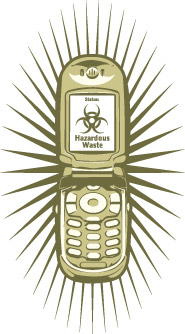| |
 |
Discarded
Electronics May Be Hazardous Waste |
downloadable
pdf
The
devices that make possible e-mail, e-news and e-commerce may
end their days as e-hazardous waste.
 A
just-completed study by University of Florida environmental
engineers found that electronic-age gadgets ranging from cell
phones to computer mice often release enough lead in laboratory
tests to be classified as hazardous waste under U.S. Environmental
Protection Agency regulations. A
just-completed study by University of Florida environmental
engineers found that electronic-age gadgets ranging from cell
phones to computer mice often release enough lead in laboratory
tests to be classified as hazardous waste under U.S. Environmental
Protection Agency regulations.
The findings, presented in a draft report to the EPA, which
funded the study, could prompt the federal government or individual
states to change the disposal rules for millions of tons of
electronic devices that now routinely make their way into
household trash landfills, said UF environmental engineering
Associate Professor Tim Townsend, lead investigator on the
project.
“The bottom line is that when we tested these devices,
in many cases they met the EPA definition for regulated hazardous
waste,” said Townsend, who presented his findings at
an EPA meeting in Chicago in February.
Rapid changes in technology make the issue of “e-waste”
pressing. Experts estimate that more than 20 million personal
computers became obsolete in 1998 alone, and project more
than 60 million personal computers will be retired in 2005,
Townsend said.
Five years ago, Townsend headed research that concluded cathode
ray tubes — the “picture tubes” that produce
images on standard television and computer screens —
release enough lead to be classed as hazardous waste. The
finding concerned state and federal officials, prompting the
EPA to provide Townsend $40,000 to test other electronic devices.
In research that began late in 2001, Townsend and four UF
graduate students examined cell phones, printers, flat-panel
monitors, keyboards, computer mice, remote controls, VCRs,
laptops and central processing units, or CPUs, the components
that contain the “guts” of personal computers.
The researchers subjected many of the e-devices to a standard
EPA testing procedure for hazardous waste, the Toxicity Characteristic
Leaching Procedure. The procedure involves mixing the ground-up
devices with an acid solution designed to simulate potential
conditions in landfills. Technicians rotate the mixture for
18 hours in a drum container, and then test the results for
eight hazardous metals: mercury, arsenic, cadmium, barium,
silver, selenium, chromium and lead.
While the UF technicians were able to grind up the smaller
devices, such as cell phones, the task proved difficult for
the larger devices such as VCRs, Townsend said. As a result,
they developed a modified version of the test: a sealed 55-gallon
drum suspended on an axle connected to a large electric motor.
They placed disassembled printers and other large electronic
devices in the drum, added the acid solution, rotated the
contents for 18 hours and then tested the leachate.
Every type of electronic device leached lead above the hazardous
waste levels in at least some cases, the tests showed. The
lead comes from the solder used to connect the circuits. None
of seven other hazardous metals showed up as problems in the
tests.
For
example, 28 of 38 cell phones tested using the standard procedure
produced leachate that exceeded the EPA standards of five
milligrams of lead per liter. Seven of eight VCRs tested with
the modified test exceeded the standard.
Curiously, the experiments found that computer CPUs frequently
exceeded the hazardous waste limit in the modified test, but
rarely in the standard test.
Upon closer look at the data, the researchers realized the
CPUs and other devices containing a large amount of steel
tended to leach less lead when the devices were ground up,
which they determined resulted from the electrochemical conditions
of the solution.
Townsend said that the laboratory leaching test results provide
a good tool, but they may not do a good job of mimicking what
happens in actual landfills. To address this question, he
has launched a major experiment at the North Central Landfill
in Polk County. The experiment will involve burying 16-foot-long,
two-foot-wide columns in the landfill, filling the columns
with a mixture of municipal solid waste and electronic waste
and testing the resulting leachate.
The two-year project is being sponsored by Polk County and
the Florida Center for Solid and Hazardous Waste Management,
a research center hosted by UF’s College of Engineering
and funded by the Florida Department of Environmental Protection.
Tim
Townsend ttown@ufl.edu
by
Aaron Hoover
|

